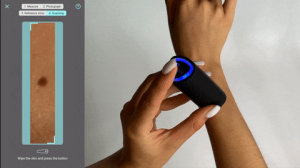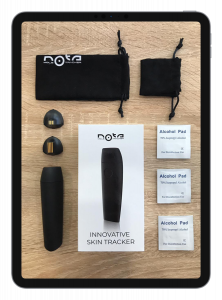Dr. Jessica Perez Ares Ruz, oncodermatology, cosmetology, Mexico,
Dr. Myasnyankin M. Yu. Phd, oncologist-surgeon, dermatooncologist, Estonia”
— Reviewer
SAN FRANCISCO, CA, USA, December 5, 2022 /EINPresswire.com/ — The gold standard the treatment (diagnosis) of this skin oncopathology is a radical surgical approach (biopsy), which, with overdiagnosis or false suspicions of the poor quality of the pigment formation, leads only to aesthetic defects and financial expenses, not counting the psychological status of the patient until the results of the histological examination are received. However, the prospects of unjustified biopsies or wide excisions based on the only existing non-invasive diagnostic method-examination (with or without a dermatoscope) with a subjective assessment by a specialist of very conditional signs according to the ABCDE system (asymmetry, irregularity of edges, color heterogeneity, size and “change” of the formation), which are probabilistic and often subjective, having no connection with evidence-based medicine. And if we take into account the differences in the prognosis for early and advanced stages of melanoma, which are statistically predominant, despite the modern breakthrough in the systemic treatment of melanoma, a large number of unnecessary manipulations of diagnostic surgery with “visual” suspicion, financial the costs of this diagnostic approach seem to be a completely unsolved problem.
According to statistics in the United States in 2020, out of 3,000,000 pigmented neoplasms subjected to biopsy, less than 200,000 turned out to be melanomas. For one detected melanoma, there are from 20 to 39 unnecessary biopsies (depending on who makes the decision about a biopsy – a certified dermatologist or a general practitioner). And this is only half of the trouble (its smaller part). Much worse is the possibility of false-negative conclusions that are present at both stages of the available to us now there is an early diagnosis. The ambiguity and subjectivity of the criteria leaves many early melanomas unrecognized in a timely manner (recognized as not suspicious enough for a biopsy). Moreover, even at the stage of analysis of the biopsy material, early melanoma can be missed in a large percentage of cases. Due to the mass of biopsies of pigmented neoplasms in routine practice , less than 2% of the volume of removed tissue is examined, which, together with blurred boundaries between atypical nevus and melanoma in situ, leads to the risk of false-negative conclusions at the early (most prognostically favorable with timely treatment) stages of the disease in situ / Ia in 16-36%. Thus, taking into account both the low sensitivity and the specificity of the currently available the total information content of the diagnostic standard is extremely small, which on the one hand leads to a huge number of unnecessary biopsies for benign formations, on the other – to the “omission” of really existing melanomas. However , the situation may change dramatically for the better in the near future.
In this regard, the most promising method is the spectrometric bioimpedance analysis (sbascopy)using the NOTA device. This device allows you to assess the state of organs and systems of biological objects when various external influences (burn, anesthesia, frostbite, etc.), as well as oncological diseases. It differs from all existing devices in that it allows you to simultaneously obtain impedance data (impedanscans) at different frequencies of the probing current. Patients with malignant tumors were studied skin neoplasms using a bioimpedance spectrometry device. The analysis of the comparison of the impedance data on patients with skin tumors and unaffected skin showed that the impedance of the skin affected by oncopathology differs at different frequencies, i.e. the electrical resistance of the patient’s skin tumor changes several times. Thus, the developed bioimpedance spectrometry device makes it possible to diagnose pigmented oncopathology.
A prospective study conducted by us showed that a very simple (only two a non-invasive approach can increase the sensitivity of melanoma detection (i.e., detecting melanoma where it really exists) by up to 99%, while reducing the need for biopsies (i.e., the number of false-positive conclusions leading to a biopsy) by the same 99%. For sbascopy, a specially developed device by Artes is used for bioimpedance diagnostics of melanoma and dysplastic nevi of high risk of malignancy-NOTA. Measurement (impedance scan) is performed from the surface of a suspicious object in relation to the development of melanoma of pigmented formation, and then the impedance is removed with a nearby and unchanged area of the skin. To obtain a larger volume of material and a more reliable answer, the procedure is repeated three times with measurements from the same sites. Thus, all skin formations are examined, both by a specialist and by the patient himself, while a biopsy can only be performed by a doctor, based on visual signs of melanoma, as mentioned above, and only 2% of the formation is examined.
Thus, it seems that in the near future we can get a diagnostic method that allows us to reduce by 99% the need for performing completely unnecessary biopsies, surgical approaches when consulting a patient with pigmented skin formation. At the same time, a more thorough morphological study, which the laboratory can afford, is spared from the” shaft ” of unnecessary biopsies materials that will reduce the risk of missing melanoma. Obviously, this approach it leads to a reduction in diagnostic costs, as well as significantly improves the quality of life of patients who have avoided unnecessary invasive manipulation and related complications. Our experience of spectrometric bioimpedance analysis in the diagnosis of skin oncopathology using NOTA opens up new opportunities due to the fact that impedanscans have comparable effectiveness with already known methods of non-invasive diagnostics. Sbascopy is very significant when making such a complex diagnosis as melanoma of the skin, which requires immediate surgical treatment, and dysplastic nevus of the skin, in which case there is a high risk of malignancy.
Ann Goldberg
Artes Electronics
+1 315-636-5213
email us here
Visit us on social media:
Facebook
Twitter
LinkedIn
Other
NOTA mole tracker – Early diagnosis of skin cancer at the price of a smart watch
![]()





